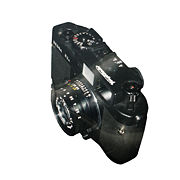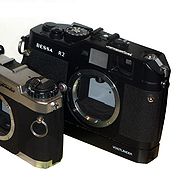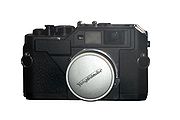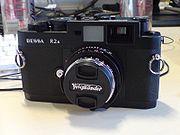
35mm Bessa
Encyclopedia

Cosina
is a designer and manufacturer of cameras and lenses, and a glassmaker, based in Nakano, Nagano Prefecture, Japan.-History:Cosina is the successor to Nikō , a company set up as a manufacturer oflenses in 1959...
as a revival of the Voigtländer
Voigtländer
Voigtländer is an optical company founded by Johann Christoph Voigtländer in Vienna in 1756 and is thus the oldest name in cameras. It produced the Petzval photographic lens in 1840, and the world's first all-metal daguerrotype camera in 1841, also bringing out plate cameras shortly afterwards...
brand name.
All the Cosina Voigtländer
Cosina Voigtländer
Cosina Voigtländer refers to photographic products manufactured by Cosina under the Voigtländer name since 1999. Cosina leases rights to the Voigtländer name from Ringfoto...
Bessa models have a double focal plane shutter with two sets of curtains to prevent damage by the sun. Shutter speeds range from 1 to 1/2000s and bulb (B), with flash sync at 1/125s on hot-shoe or PC terminal. They all have TTL exposure metering, and manual exposure; the recent R2A and R3A also have an aperture priority automatic mode.
The Bessa L and T (finderless)

Nikon
, also known as just Nikon, is a multinational corporation headquartered in Tokyo, Japan, specializing in optics and imaging. Its products include cameras, binoculars, microscopes, measurement instruments, and the steppers used in the photolithography steps of semiconductor fabrication, of which...
and even cheaper but often excellent Soviet lenses.
The Bessa L was mostly intended to be used with ultra wide angle lenses, with which the absence of a focusing device is not a problem. Most notably Voigtländer introduced a 15mm and a 12mm lens, the latter being the widest rectilinear lens ever marketed.
The Bessa L has TTL metering with LED readout on the back edge of the top plate with an ASA range of 25–1600 and an EV range 1 to 19 at ASA 100. The readout consists of two red arrows pointing to a green light in between that enables use of the camera as, effectively, a shutter priority, aperture priority, or totally manual camera.
On some markets, the Voigtländer Bessa L was sold as the Cosina SW-107.
The Bessa L was supplemented in 2001 by the Bessa T, which used the Leica M-mount
Leica M mount
The Leica M mount is a camera lens mount introduced in 1954 with the Leica M3, and a range of lenses. It has been on all the Leica M series up to the current film Leica M7 and digital Leica M9....
, could receive a trigger advance design, and had an integrated rangefinder with high magnification, but no viewfinder. It was sold in silver or black; from 2002, also in gray or olive (at a higher price and perhaps only in Japan). It is now discontinued but some stock is still available.
In 2001, the Bessa T was sold in a special kit, called 101st Anniversary (in short "T101"), with a 50mm f:3.5 collapsible Heliar lens, for the anniversary of the Voigtländer Heliar lens design. It existed in black, grey, olive and blue: five hundred numbered examples were produced for each color.
The Bessa R and R2 (manual rangefinder)

Viewfinder
In photography, a viewfinder is what the photographer looks through to compose, and in many cases to focus, the picture. Most viewfinders are separate, and suffer parallax, while the single-lens reflex camera lets the viewfinder use the main optical system. Viewfinders are used in many cameras of...
was comparable in function and feeling. It featured manually selectable frames for 35mm/90mm, 50mm, and 75mm lenses. The body, made of polycarbonate plastics, was not comparable to that of a Leica but was solid enough. All in all it was an inexpensive, all-manual rangefinder with TTL
TTL
TTL may refer to:* Taiwan Tobacco and Liquor, a state-owned manufacturer of cigarettes and alcohol in Taiwan* Through-the-lens metering, a feature of cameras capable of measuring light levels in a scene through their lens...
metering at a significantly lower price than a comparably equipped Leica M camera. It was available in black or silver; from 2002, also in navy blue or olive (at a higher price and perhaps only in Japan).
The Bessa R2 replaced the Bessa R in 2002. It was an updated version, with a Leica M-mount
Leica M mount
The Leica M mount is a camera lens mount introduced in 1954 with the Leica M3, and a range of lenses. It has been on all the Leica M series up to the current film Leica M7 and digital Leica M9....
replacing the Leica screw mount, and the ability to take the same trigger advance accessory as the Bessa T. Its quality of fabrication and overall finish was much better than the R, with magnesium alloy replacing the former model's plastic plates and a more substantial cast (as opposed to pressed) metal film rewind lever. The changes resulted in a more solid and marginally larger camera, available in either olive (with chrome detailing) or splatter-textured black paint finishes. Note that the Bessa R's self timer was deleted from the R2, possibly due to the packaging constraints imposed on the design by the adoption of thicker metal panels.
The Rollei 35 RF
The names Cosina, Voigtländer and Bessa appear nowhere on the Rollei 35 RFRollei 35 RF
The Rollei 35 RF is a version of the Cosina Voigtländer Bessa R2 marketed not by Cosina but instead by Rollei, complete with a Rollei 40mm lens....
(2002), marketed not by Cosina but instead by Rollei
Rollei
Rollei is a German manufacturer of optical goods founded in 1920 by Paul Franke and Reinhold Heidecke in Braunschweig, Lower Saxony, and maker of the Rolleiflex and Rolleicord series of cameras...
. But this camera is very obviously based on the Bessa R2. The most obvious differences are the price (much higher) and somewhat gaudy appearance; more importantly the framelines are for 40, 50, and 80mm. Arguably it remains the best Bessa camera for people who wear glasses and primarily use a 40mm lens.
The Bessa R2S and R2C (Nikon and Contax mount)

Nikon S-Mount
The Nikon S-mount is a type of interchangeable lens mount used by a series of Nikon 35mm rangefinder cameras...
and the R2C a Contax rangefinder mount. They are both discontinued today but stock is still available.
At about the time in 2005 when discontinuation of these two models was announced, the Bessa R2S was also available in a "Nikon Historical Society" version with special paintwork and a rigid version of the Heliar f/3.5 50mm lens sold earlier with the Bessa T. The set was (and as of May 2006 still is) available to the general public through regular retail channels in the US: Society membership is not required.
The Bessa R2A and R3A (auto-exposure rangefinder)

Leica M mount
The Leica M mount is a camera lens mount introduced in 1954 with the Leica M3, and a range of lenses. It has been on all the Leica M series up to the current film Leica M7 and digital Leica M9....
and an aperture-priority automatic exposure, switchable to manual. The R2A has a finder with a 0.7x maginification, and 35/50/75/90 frame lines. The R3A has a finder with a 1x magnification, and 40/50/75/90 frame lines. Both can take the trigger advance accessory.
They are currently sold in textured black or flat grey paint finishes.
These cameras feature an electronic shutter, making the camera inoperable without batteries.
The Bessa R2M and R3M (manual rangefinder)
The Bessa R2M and Bessa R3M, both announced in Germany around March 2006 and in May elsewhere, are limited-edition manual-exposure, mechanical-shutter equivalents of the R2A and R3A, sold with a 50mm f/2 M-mount collapsible Heliar lens. The exposure display in the finder is more elaborate than that in the R2.They are to be sold in black (1000 examples of the R3M, 500 of the R2M) or silver (700 of the R3M, 300 of the R2M).
The Bessa R4M and R4A (wide-angle rangefinder)
Announced in October, 2006 at Photokina, the Bessa R4M and Bessa R4A were the first Leica M-mountLeica M mount
The Leica M mount is a camera lens mount introduced in 1954 with the Leica M3, and a range of lenses. It has been on all the Leica M series up to the current film Leica M7 and digital Leica M9....
cameras to include framelines wider than 28mm. The R4-series keeps the same features as the R3-series, but utilizes a wide-angle-specific viewfinder with .52x magnification and framelines for 21, 25, 28, 35, and 50mm lenses. Like the previous limited edition R-series cameras, the R4A features aperture-priority autoexposure, while the R4M features full manual operation, including a mechanical shutter that will continue to work even if the battery (which powers the meter) is dead.
The R4M is available in the classic black of the R2 and R3-series, while the R4A is available in matte black.
External links
- Bessa L by Alfred Klomp
- Bessa R by Mike Elek
- An unofficial Voigtländer FAQ, edited by Peat Bakke
- Cosina Voigtländer Cosina's own site (in Japanese)
- Ringphoto Voigtländer (in German)
- Stephen Gandy is the US importer of the Bessa and maintains informative pages at Cameraquest
- The entry in the Leica FAQ
- Peter Wolff's Bessa R2 review
- User reviews at PhotographyReview.com
- Lionel's Voigtländer Bessa R overview at 35mm-compact.com
Images
- Bessa R sample photos at pbase.com
- Bessa R2 sample photos at pbase.com
- Bessa R tag at flickr.com
- Bessa R2 Gallery Peter Chou's Bessa R2 Gallery

